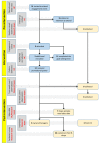Feasibility of working with a wholesale supplier to co-design and test acceptability of an intervention to promote smaller portions: an uncontrolled before-and-after study in British Fish & Chip shops
- PMID: 30782880
- PMCID: PMC6377521
- DOI: 10.1136/bmjopen-2018-023441
Feasibility of working with a wholesale supplier to co-design and test acceptability of an intervention to promote smaller portions: an uncontrolled before-and-after study in British Fish & Chip shops
Abstract
Objectives: To explore the feasibility of working with a wholesale supplier to co-design and deliver, and to assess the acceptability of, an intervention to promote smaller portions in Fish & Chip shops.
Design: Uncontrolled before-and-after study.
Setting: Fish & Chip shops in northern England, 2016.
Participants: Owners (n=11), a manager and customers (n=46) of Fish & Chip shops; and intervention deliverers (n=3).
Intervention: Supplier-led, three-hour engagement event with shop owners and managers, highlighting the problem of excessive portion sizes and potential ways to reduce portion sizes; provision of box packaging to serve smaller portions; promotional posters and business incentives.
Data collection: In-store observations and sales data collected at baseline and postintervention. Exit survey with customers. Semistructured interviews with owners/managers and intervention deliverers postintervention.
Results: Twelve Fish & Chip shops were recruited. Observational data were collected from eight shops: at baseline, six shops did not promote the availability of smaller portion meals; at follow-up, all eight did and five displayed the promotional poster. Seven out of 12 shops provided sales data and all reported increased sales of smaller portion meals postintervention. Of 46 customers surveyed: 28% were unaware of the availability of smaller portion meals; 20% had bought smaller portion meals; and 46% of those who had not bought these meals were interested to try them in the future. Interviews revealed: owners/managers found the intervention acceptable but wanted a clearer definition of a smaller portion meal; the supplier valued the experience of intervention co-production and saw the intervention as being compatible with their responsibility to drive innovation.
Conclusions: The co-design of the intervention with a supplier was feasible. The partnership facilitated the delivery of an intervention that was acceptable to owners and customers. Sales of smaller meal packaging suggest that promotion of such meals is viable and may be sustainable.
Keywords: diet; food environments; obesity; public health; takeaways.
© Author(s) (or their employer(s)) 2019. Re-use permitted under CC BY. Published by BMJ.
Conflict of interest statement
Competing interests: The research funding contributed to the cost of design and production of some of the intervention materials. HC also contributed to the costs of intervention development and funded delivery. HC developed and sell the ‘Lite-BITE®’ Fish & Chip meal boxes detailed in the study. Neither the project, nor individual researchers received financial contributions from HC for this study or any other work. MWh is funded by NIHR as Director of its Public Health Research Funding Programme. AJA is funded by NIHR as a Research Professor and the National Director of NIHR SPHR. CS and MWh are principal investigators in the NIHR SPHR. MWo led and delivered the intervention and provided the packaging materials; at the time of the research he was an undergraduate student at Newcastle Business School, Northumbria University on secondment to HC. After completion of the study (and his degree programme at Northumbria University), he became an employee of HC. HC an independent supplier to over 2500 Fish & Chip Shops in the North-East of England, Yorkshire, Cumbria and Scotland. HC is a private limited company founded in 1893 and based in Gateshead, North-East England. Company number 00822749 (www.colbeck.co.uk).
Figures
References
-
- Jaworowska A, M. Blackham T, Long R, et al. . Nutritional composition of takeaway food in the UK. Nutrition & Food Science 2014;44:414–30. 10.1108/NFS-08-2013-0093 - DOI
-
- Public Health England. Calorie reduction: the scope and ambition for action: Department of Health and Social Care, 2018.
MeSH terms
Grants and funding
LinkOut - more resources
Full Text Sources


